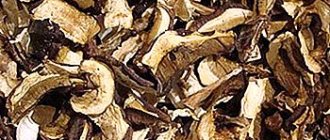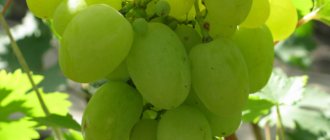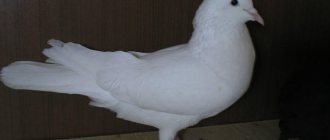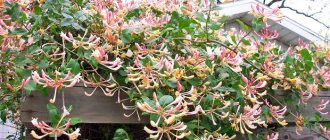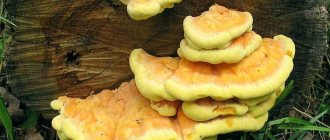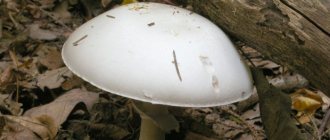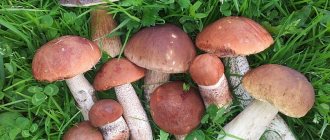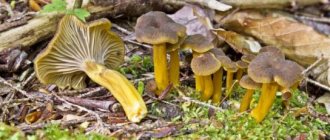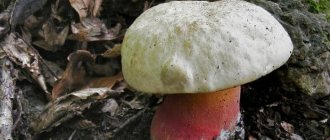For an experienced mushroom picker, the question of how a milk mushroom differs from a squeaky mushroom will not be a reason for long thought. He knows very well all the differences that make it possible to eliminate the risk of inedible and poisonous specimens ending up in the basket. We invite you to learn how to distinguish white milk mushroom from mustard, violin, volnushka, row and other mushrooms that are similar in appearance. The page provides comparative characteristics and full descriptions of similar types of mushrooms. Be sure to look at how to distinguish white milk mushrooms from false ones in the photo, which illustrates all the typical signs. This will help you feel more confident during a “quiet hunt” in the forest. Pick mushrooms very carefully. Recently, cases of poisoning from eating seemingly familiar types of mushrooms have become more frequent. In fact, there is active mimicry and poisonous mushrooms become very similar to edible ones in appearance.
The main differences between milk mushrooms
The cap is round, usually concave inward, funnel-shaped, white or yellowish in color, with large rusty spots, moist, slightly fluffy, with a large fringe along the edges. The plates are white, yellowish. The pulp is white, dense, juicy, thick, and secretes a bitter milky juice, especially when broken. The leg is short, white, hollow inside. They belong to the “plate” mushrooms, in which the lower part of the caps consists of delicate plates. Next, we will look at the main differences between milk mushrooms and a number of mushrooms that are similar in appearance.
Grows in birch forests and mixed forests with an admixture of birch. It is found quite rarely, but sometimes in large groups, from July to October. The cap is large, up to 20 cm in diameter, in young mushrooms it is white, rounded-convex, then funnel-shaped, with a shaggy edge turned down, white or slightly yellowish, often with faintly noticeable watery concentric stripes. In damp weather it is mucous, which is why this mushroom is called “raw milk mushroom”. The pulp is white, dense, brittle, with a spicy odor.
The milky juice is white, acrid, bitter in taste, and turns sulfur-yellow in air.
The plates descending along the stalk, white or cream, with a yellowish edge, wide, sparse. The stem is short, thick, bare, white, sometimes with yellowish spots, and in mature mushrooms it is hollow inside. Conditionally edible, first category. Used for pickling, less often for pickling. Salted milk mushrooms have a bluish tint.
External characteristics and description of the mushroom
The fleshy body has a unique taste and smell. Also, the edible violin mushroom has the following distinctive features:
hat
- The structure is fleshy, dryish, with a felt surface, creaks when in contact with other objects
- The diameter of the cap changes during the ripening of the mushroom from 5 to 26 cm
- During the period of growing up, the shape of the cap changes from flat, or slightly protruding towards the center with low sides, to funnel-shaped with cracked edges
- The color changes its palette from milky to more saturated with a tint of ocher and interspersed with yellow spots
Hymenophore (lower part of the fleshy body)
- Has a plastic look
- Rare plates 3-8 mm wide are located along the area of the hymenium and have a greenish-cream tint, which later hang down on the stem of the mushroom. With age they acquire a yellowish tint
- The controversial material is spiky, white in color
Skripnitsa mushroom is almost like milk mushroom, only healthier
Pulp
- Bitter to taste, hard, brittle and easily crumbles when pressed
- Milky juice is released. Reacting with air it turns yellow and when it dries it turns reddish brown.
Leg
- Straight, without bends, tapering towards the cap
- Felt surface, bright white
- Reaches a length of 6-6.5 centimeters with a thickness of no more than 4 cm
- Dense pulp structure
Skripnitsa mushroom is almost like milk mushroom, only healthier
What is the difference between a white breast and a black one?
Grows in coniferous and deciduous forests. Occurs singly and in groups from July to October, and sometimes in November. The cap is up to 20 cm in diameter, almost flat, with a depression in the middle and a curled edge. Later, the cap becomes funnel-shaped with straightening edges. The surface is slightly sticky, olive-brown, lighter towards the edge. The first thing that distinguishes a white mushroom from a black one is the color of the outer color. The plates are dirty whitish, later with brownish spots. They darken when pressed.
The leg is short, thick, at first solid, then hollow. The pulp is dense, white or grayish-white, with abundant white acrid milky juice, darkening at the break. Black milk mushrooms are good for pickling. Thoroughly washed and soaked, they lose their bitterness, their flesh becomes crispy and dense. When salted, the cap acquires a beautiful dark purple-cherry color. Black milk mushrooms in salting do not lose their strength and taste for years. Conditionally edible, third category.
How to cook milk mushrooms correctly?
Preparation for pickling for milk mushrooms lasts a little longer than for other mushrooms. Without delaying the process, they need to be sorted and cleaned immediately. After that, rinse it well several times in cold water, trying to remove all the sand as much as possible (otherwise it will subsequently grate unpleasantly on your teeth). Now you can start soaking. This stage lasts from one to three days. The water should be changed at least three times a day. And only then can you pickle the mushrooms. Some people recommend boiling them for ten minutes before doing this, but experienced mushroom pickers note that in such cases the real taste and aroma of the mushroom will be lost.
Cooking white milk mushrooms and other types of these mushrooms is simple. You need to take 40 g of salt for every kilogram. Place them in containers (preferably wooden tubs) with their caps up, sprinkling them in layers with salt. If desired, you can add cherry, currant, oak leaves, garlic cloves and pepper. However, it is worth remembering that the sharp aroma of herbs and spices interrupts the true smell of mushrooms. After the container is filled, it is removed to a cool place and placed under pressure.
Salting milk mushrooms should last at least 30-40 days (or even two months) - this is the time required for complete fermentation. And only then can they be eaten. Although some mushroom pickers believe that only one or two weeks is enough. But it’s still not worth risking your health.
The difference between a white load and a milk mushroom
The cap of the milk mushroom is more concave than that of a real milk mushroom, less fluffy. In young caps, the edges of the cap are also turned inward, but not completely lowered. The hat and rare plates are white. The pulp is white; when broken, a bitter milky juice is released. The dry surface and white color are the distinguishing features of this mushroom.
Grows from late July to late autumn. The main difference between white mushroom and milk mushroom is that it is found in coniferous, deciduous and mixed forests in the northern part of the forest zone. Grows from July to October. The cap is white - up to 20 cm in diameter - at first flat-convex with a curved edge and a depression in the middle, then funnel-shaped with straightening edges, pure white, sometimes with brownish-yellow spots (scorches). The leg is up to 5 cm long, smooth, at first solid, then hollow, white. The flesh is white, does not change at the break, the flesh in the cap tissue is moist, in the plates it is caustic. The plates are descending, narrow, clean, sometimes forked towards the outer edge, bifurcated, white.
Usually this mushroom is salted. The salted load acquires a slightly brownish color. In many places, white milk mushrooms are called “dry milk mushrooms” in contrast to real milk mushrooms, which usually have a slightly slimy cap. White milk mushrooms differ from real milk mushrooms in other ways. The edges of their caps are not pubescent, and the flesh does not contain milky juice. Conditionally edible, second category, used salted and pickled. In the northern half of the forest zone there is another type of podgrudok - black podgrudok. The cap is up to 15 cm in diameter, flat-convex with a depression in the middle and with a curled edge, later funnel-shaped, glabrous, slightly sticky, from dirty gray to dark brown in color.
The pulp is white or grayish-white, without milky juice.
The plates are often grayish-dirty in color and turn black when pressed. Due to the dark color of the cap, the mushroom is sometimes called “grain”, and because of its fragile flesh – “black russula”. These mushrooms are often wormy. Its plates are very caustic. For salting, it must be boiled. When salted and boiled, it is dark brown in color. Conditionally edible, third category, used only for salting. Salted mushrooms turn black.
Look at the difference between milk mushrooms and subloads in the photo, which shows the main differences.
False milk mushrooms: can they be eaten?
The group of conditionally edible mushrooms is very large. At the same time, experienced mushroom pickers hunt for them with pleasure, because such specimens are quite suitable for food. The main thing is to soak or boil them additionally before cooking. They are great for pickling and pickling. In particular, housewives value real and false milk mushrooms, which include more than 10 different types.
False milk mushrooms: can they be eaten?
Description of mushrooms
False milk mushroom is a welcome guest on the holiday table, but not all housewives take up the preparation, preferring more familiar types. The reason for this is the white milky juice contained in the cap and stem, which can take on a yellowish tint in the air and has a sharp-bitter taste.
Real white milk mushrooms are considered the best for pickling.
Etymology of the name
There are different versions:
- The mushroom is named so because of its large weight, at which it appears heavy and heavy.
- The origin comes from the word “heap”, which means a lot.
Both options have the right to life, since some individuals reach decent sizes, massive due to the abundance of juice in the cap.
Peculiarities
Milk mushrooms grow in clusters or paths. Having found one specimen, you can be sure that you won’t be able to go home without some loot, you just need to carefully inspect the surrounding area.
The average temperature for the growth of milk mushrooms is 7-10℃. According to old mushroom pickers, it is best to start “hunting” for this mushroom after long, but not heavy rains. To collect, you will need a stick and a sharp knife.
They choose sunny clearings as habitats and do not hide in the shade. After rain, the cap becomes slippery, like a butternut cap, and the shape is always slightly concave, funnel-shaped.
Fruit bodies contain vitamin D of non-animal origin, and are also rich in protein (up to 30%), such an amount can replace meat.
Another nice feature: the almost complete absence of pests on mushrooms, so even caps with a large diameter will not be wormy. Insects do not like the specific taste and try to stay away.
Beneficial features
Mushrooms are recommended for those who are on a diet. Eating them regularly also helps:
- replenish mineral deficiency;
- increase immunity during epidemics and when there is a threat of tuberculosis, since the composition contains substances that resist Koch's bacillus;
- stabilize the nervous system;
- improve digestion;
- activate the process of removing toxins.
All milk mushrooms, including false ones, must be soaked to remove the bitterness from the milky juice. The difference in processing time is dictated by the characteristics of a particular species.
Skripun
Description
All varieties of milk mushrooms need to be soaked
Outwardly, it is very similar to a real milk mushroom: the same weighty fruiting body, squat leg.
The cap is white, size from 8 to 20 cm, the plates on the inside are sparse, the shape is concave, reminiscent of a funnel.
Most often, the mushroom grows in birch groves and mixed forests, and in favorable weather it produces abundant harvests.
How is it different from milk mushrooms?
To establish the truth, it is enough to cut or break the cap and look at the color of the juice. In violin, it takes on a reddish tint after drying.
Irina Selyutina (Biologist):
In addition to changes in the color of the milky juice, the violin is characterized by the following features that distinguish it from milk mushrooms:
- the plates of the hymenophres in young specimens are yellow, and in mature ones they are much lighter in color, while in real milk mushrooms they are white with a yellowish tint;
- the leg is short and thick, tapering towards its base and covered with small fluff. This feature gave the mushroom another name - felt mushroom.
The double is also assigned edibility class 4, which means longer soaking - up to 5 days.
The harvest time comes a little earlier, already from mid-July. If you run a fingernail (knife) along the cap, or when you put fruiting bodies in a basket and they touch each other, a characteristic squeak occurs.
The mushroom is not recommended for dry storage; it can be salted or pickled.
Gorchak
Description
More similar to boletus, sometimes it is confused with boletus.
It is inedible because no measures can remove the bitter, nasty taste. If at least one representative gets into the soup, the dish will be spoiled irrevocably.
The bitterness does not break down during heat treatment, but is enhanced many times over.
If a specimen was found near a rotten stump and was never bitten by anyone, despite its impressive size, then rest assured that it is a bitterling.
How is it different from milk mushrooms?
It does not look like milk mushroom at all; it is impossible to confuse it with agaric mushrooms.
Externally, it slightly matches the white one: it is also stocky, stands confidently on a strong thick leg, the inside of the cap is spongy.
You can distinguish it only by taste. It is enough to lightly lick the edge - if you feel bitterness, you should immediately rinse your mouth and throw the mushroom away.
Also pay attention to the stem on the cut: in bitterling it turns pink.
Pig
Description
It got its name for its shape, similar to a pig's ear.
The mushroom is inedible; when compounds characteristic of it accumulate in the body, it adversely affects the production of red blood cells - erythrocytes.
It grows in groups - from July to September. Prefers shady and damp places, the cap has a characteristic shape, yellow-brown color, with darker spots.
How is it different from milk mushrooms?
Sometimes pigs are called black milk mushrooms. It is seriously different from its inedible counterpart.
First of all, it is edible, when salted it is endowed with an excellent taste, has a darker color of the cap with an olive tint, and when broken, a milky juice is released.
How do milk mushrooms differ from milk mushrooms?
It grows from the end of August until the first frost, mostly alone in birch forests and mixed forests, mainly in the northern part of the forest zone. The cap is up to 12 cm in diameter, at first flat with a hole in the center and with a rolled edge, later funnel-shaped, fibrous, shaggy and woolly along the edge. Let's figure out how milk mushrooms differ from milk mushrooms and how to differentiate them in the field.
In wet weather, the middle of the cap is sticky, pink or yellowish-pink, with pronounced dark concentric zones. The plates are adherent or descending, thin, white or slightly pinkish. The leg is up to 6 cm long, up to 2 cm in diameter, cylindrical, hollow, one-color with a cap. The pulp is loose, brittle, white or pinkish, with white, pungent, acrid milky juice. Volnushka is used for salting. It is pickled only after thorough soaking and boiling, otherwise the mushrooms can cause severe irritation of the gastric mucosa. It is best to pick young mushrooms for salting, up to 3-4 cm. Their cap is strong, with the edge wrapped deep inside. Such small waves are called “curls”. When salted, it has a pale brown color with an admixture of pink, and retains pronounced dark zones. In the northwestern and central regions of the country and in the Urals, usually on the edges of young birch forests from the beginning of August to October you can find the white moth. It is in many ways similar to the pink wave, but smaller. The cap, up to 6 cm in diameter, is fluffy-silky, at first convex, later funnel-shaped, white with yellowish-reddish, blurry spots, with a curled hairy edge. The white milky juice is pungent and sometimes bitter. The plates are light fawn, slightly pinkish, adherent or descending, frequent, narrow. The leg is dense, brittle, short, smooth. The flesh is white or slightly pinkish. Belyanka is sometimes confused with white podgruzdka. But the latter has a much larger cap, and the edge is bare or slightly pubescent. It is only used for pickling after preliminary soaking in water or scalding with boiling water. Belyanka is valued for its delicate pulp and pleasant taste. When salted it is light brownish. The mushroom is conditionally edible, second category.
Mushrooms similar to milk mushrooms
Mushrooms are often similar to each other, and even experienced foresters may not know all the differences. Check out several species that can easily be confused with milk mushrooms. Consider the specific descriptions and be careful when collecting in forests.
Spruce row
The mushroom prefers damp coniferous forests and begins to appear from late August to early September. The row has a very unpleasant smell and taste. Young representatives of the species look like greenflies. However, they are brown in color.
The cap has a tubercle, its structure is fleshy. The hollow leg, which is not hidden under the cap, is clearly visible. Favorite place for rowing is mossy ground. The plates are pale, as is the leg. Adult mushrooms crack.
Milky
A lamellar representative of the Russula family. Grows in forests and meadows. It is also called smoothie. The milky mushroom is almost a double of the milk mushroom. Some species appear almost identical.
Characteristic signs of the laticifer:
- The cap reaches 15 cm in diameter. Its shape is funnel-shaped. The color changes from brown to almost lilac or purple. The surface is slimy and smooth. The pulp is thick yellowish. The white milky juice turns slightly green in the air.
- The plates are frequent and pale cream in color. Adult mushrooms leak juice and yellow spots appear.
- The spore powder is colored light yellow.
- The hollow stem can grow up to 15 cm or remain low, lighter in color than the cap.
Volnushka white
Whitefish loves the edges of birch forests or coniferous-birch areas. From the beginning of October to the end of August, this species appears on the soil surface in large groups. The mushroom cap is from 4 to 8 cm. Its shape varies from convex to funnel-shaped. The skin is densely pubescent, white, with a dark center. Frequent and narrow plates are white.
The leg is low, up to 2 cm wide. The shape is a cylinder, tapering towards the base. The surface is slightly or completely smooth. The leg has a cavity inside. The pulp is white, rather fragile, and its smell is weak. There is a lot of milky white juice, it is very caustic, its shade remains unchanged when cut.
Toadstool
You are probably familiar with the stories about the pale grebe. We even met her in the forest. We saw its greenish tint. But sometimes this mushroom is almost white. On the surface of the caps of young representatives there are warty growths that easily disappear. The leg can be with or without scales.
The color is white, yellow or greenish. The pleasant smell of young toadstools changes over time to a sweet and cloying one. In general, this poisonous mushroom is distinguished by a thicker base of the stem and the presence of a seal on it near the cap.
Differences between violin and milk mushroom
Quite often found in coniferous and deciduous forests of the middle zone, in large groups, from mid-June to mid-September. The cap is up to 20 cm in diameter, at first flat-convex, depressed in the middle, with a curled edge. The difference between the violin and the milk mushroom is that later the cap becomes funnel-shaped with a wavy, often cracked edge. The surface is dry, slightly pubescent, pure white, later slightly buffy. The plates are sparse, whitish or yellowish. The leg is up to 6 cm long, thick, somewhat narrowed at the base, solid, white. The pulp is coarse, dense, white, later yellowish, with abundant white, pungent, pungent milky juice. The collected mushrooms in the basket rub against each other and make a characteristic creaking sound. For this they were called “violinists”, “creakers”. Mushroom pickers do not always take these mushrooms, although they are used for salting, becoming strong and acquiring a mushroom smell. The mushroom becomes white with a bluish tint and squeaks on the teeth. The mushroom is conditionally edible, category four. Used for salting and pickling. It must first be soaked and boiled to remove bitterness.
Distribution and collection season
Skripitsa is actively growing in areas from Western Europe to the Far East. The creaking bird settles with equal pleasure in coniferous, mixed and deciduous forests, as long as there is enough moss and old leaves on the ground, and the area is well lit by the sun. He especially “respects” the proximity of birch and aspen.
Violins grow in large groups of different ages, but single specimens can also be found. Collection season – summer – autumn. Young violin mushrooms are more tasty in the second half of summer.
How to distinguish white milk mushroom from bitterling
You need to know how to distinguish white milk mushroom from bitterling, since it is found everywhere, but mainly in the northern half of the forest zone. Prefers somewhat damp forests. Usually grows in large groups. The cap is up to 8 cm in diameter, initially flat-convex, then funnel-shaped, usually with a tubercle in the middle, dry, silky, red-brown. The plates are descending or adherent, frequent, pale reddish-yellowish, usually with a white coating from spores. The leg is up to 8 cm long, smooth, cylindrical, first solid, then hollow, light reddish-brown, with white felt at the base. The pulp is dense, at first white, then slightly red-brown without much odor. The milky juice is white and very caustic; it is not for nothing that the mushroom is called bitter. Because of the very bitter, pungent taste, mushrooms are only salted, they must be boiled first, and only then they are salted. When salted, the mushrooms are dark brown in color, with a noticeable sharp lump on the cap. The mushroom is conditionally edible, category four.
Nutritional qualities, benefits and harms
Having found creaking milk mushrooms in the forest, the question arises: “Is it possible to eat them?” The answer can be given in two ways. It is not advisable to do this in its raw form, since troubles in the form of vomiting and irritation of the gastrointestinal tract are possible.
After proper processing, skreak loses its harmful properties and can provide the body with an impressive range of amino acids, vitamins and minerals. Contains 48.73% carbohydrates and 46.19% proteins. At the same time, per 100 g of mushroom there are only 22 kcal. This means that it can be used for dietary nutrition.
Although squeaky mushrooms are not as popular as white milk mushrooms, they also find their admirers among lovers of “quiet hunting”. Having a not too rich selection of mushrooms, you can safely put them in the basket. Properly prepared violins will successfully supplement a vitamin-poor diet in the winter and spring.
Differences between black milk mushroom and pig milk
Svinushka, a genus of lamellar mushrooms. The difference between a pig and a milk mushroom is that it has a cap with a diameter of up to 20 cm, initially convex, then flat, funnel-shaped, with an edge turned inward, velvety, yellow-brown, sometimes with an olive tint. The flesh is light brown, darkening when cut. The plates are decurrent, connected at the bottom by transverse veins, and are easily separated from the cap. Leg length up to 9 cm, central or shifted to the side, narrowed downwards, the same color as the cap. The mushroom grows in forests of various types, in large groups, from July to October, and can form mycorrhiza.
It is imperative to know the difference between black milk mushroom and pig mushroom, since in recent years pig mushroom has been classified as a poisonous mushroom (it can cause poisoning, even fatal). It contains substances that lead to a decrease in red blood cells in the blood. Moreover, the manifestation of poisoning depends on the individual characteristics of the human body and can occur either a few hours later or several years after consuming these mushrooms. The fat pig is distinguished by its larger size and dark brown velvety leg. Forms mycorrhiza or settles on wood. Conditionally edible. Pig animals have the ability to accumulate harmful compounds of heavy metals.
Mushroom poisoning: what to do?
The first symptoms of poisoning by false mushrooms are always similar to each other. After a few hours, a person begins to feel weakness and pain in the abdomen, he begins to feel sick, after which vomiting and loose stools appear. So the body tries to get rid of toxins in every way available to it. If help is not given at this stage, the condition may worsen to the point of dehydration.
First aid for poisoning with false mushrooms is gastric lavage. It is necessary to force the person to drink water or a weak solution of manganese, and then induce vomiting by pressing on the root of the tongue. The procedure should be repeated several times.
As soon as the nausea and vomiting pass, you can begin rehydration - restoring lost fluid. Sweet warm tea or pharmaceutical preparations, for example, Regidron, will help here. Drinking during this period should be plentiful. In addition, a person needs warmth and peace.
If you are poisoned by false mushrooms, you should not refuse qualified medical care. Even if everything was done correctly, consulting a specialist never hurts. You need to treat your health responsibly, and not rely on the usual and familiar “maybe”...
How to distinguish a white milk mushroom from a toadstool?
The white milk mushroom does not have a thickening in the form of a tuber, which is located at the bottom of the toadstool's stem. The toadstool itself is considered a rather dangerous mushroom. Basically, its appearance resembles that of russula.
Toadstool
The grebe has a green cap, in some cases almost white. There is a ring on the stem of the mushroom near the cap. If you do not want to confuse this mushroom with white milk mushroom, remember the following rule: mushrooms that are intended for pickling have a hole on the stem. This indicates that this or that mushroom is considered edible.
How to process milk mushrooms after harvesting?
You need to know that each mushroom tends to deteriorate quickly, therefore, they need to be washed and cleaned as quickly as possible.
- To begin, wipe the mushroom with a dry piece of cloth.
- Then remove dark places from it and clean the leg from dirt.
- If the mushroom is very dirty or wormy, then it must be placed in cool, salty water.
- After soaking the mushroom, you can cook it.
What is the difference between a milk mushroom and a spruce row?
Grows on sandy soil in coniferous, mainly pine forests from August until autumn frosts, singly and in small groups. Distributed everywhere, but quite rare. The cap is up to 10 cm in diameter, fibrous, mucous-sticky, initially flat-convex, then semi-prostrate, light gray to dark gray in color, often with a yellowish or purple tint, darker in the center than along the edge, with radial dark stripes .
The most important thing that distinguishes milk mushroom from spruce row is that its flesh is not brittle, white, does not turn yellow in the air, has a faint smell of flour, and tastes fresh. The plates are white, then light yellow or bluish-grayish, sparse, wide. The leg is up to 10 cm long and up to 2 cm thick, smooth, white, then yellowish or grayish, fibrous, sits deep in the soil. The mushroom is edible, category four. Used boiled, fried, salted and pickled.
How to deliciously cook milk mushrooms
A dish for every taste - fried milk mushrooms. Preparation begins with pre-soaking the mushrooms for two days with periodic changes of water. Cook the washed mushrooms for 5 minutes, drain the water and pour in new water, cook again for 5 minutes. Remove the mushrooms and wait to cool. Now the cap needs to be separated from the stem, they are hard in taste and will not be useful to us for frying. You can put them in the freezer for later use.
Fried milk mushrooms
The caps are cut into pieces and poured into a frying pan heated with oil. After 10 minutes of frying, the juice is poured out; it is not needed. Add greens, garlic and sunflower oil to the mushrooms, fry until golden brown and enjoy the taste.
Differences between white milk mushroom and white milk mushroom
In the northwestern and central regions of the country and in the Urals, usually on the edges of young birch forests from the beginning of August to October you can find the white moth. It is in many ways similar to the pink wave, but smaller. The difference between the white milk mushroom and the white milk mushroom is as follows: the cap, up to 6 cm in diameter, is fluffy-silky, at first convex, later funnel-shaped, white with yellowish-reddish, blurry spots, with a curled hairy edge.
The white milky juice is pungent and sometimes bitter. The plates are light fawn, slightly pinkish, adherent or descending, frequent, narrow. The leg is dense, brittle, short, smooth. The difference between milk mushrooms and milk mushrooms is that their flesh is always white, and not slightly pinkish. Belyanka is sometimes confused with white podgruzdka. But the latter has a much larger cap, and the edge is bare or slightly pubescent. It is only used for pickling after preliminary soaking in water or scalding with boiling water. Belyanka is valued for its delicate pulp and pleasant taste. When salted it is light brownish.
Can it be grown at home or in the country?
Can!
Provided that you have a sufficient amount of mycelium, this process will not cause you any particular difficulties.
Algorithms of action and necessary components for successfully growing mushrooms, both for yourself and for sale:
A simple recipe for those who could not find ready-made mycelium for growing
- Find and collect very overripe mushrooms in the forest
- Break into small pieces
- Then mix with sawdust and peat
- Fertilize with nutrient solution
- Find a lid with small holes and cover it with it.
- Preheat the room to 23 degrees Celsius
- Leave for approximately three days in these conditions.
- Immediately before planting, take a lime solution and treat the soil with it (fifty grams of lime per 10 liters of water)
- Pre-prepare recesses near a deciduous tree
- Fill the hole halfway with the substrate that was previously prepared.
- Sprinkle with previously prepared soil with lime
- Cover with moss, placing rotten leaves on top
Recipe with mecelium, for those who were still able to get it =)
- Prepare a sufficient amount of hardwood sawdust and forest soil
- Mix soil and sawdust with mycelium
- In the forest where the violinist sprouts, collect moss and rotted leaves
- During the periods from late spring to early autumn, sow the mycelium of creaks
- Prepare a nutrient solution for feeding from nutritional yeast and sugar
- Feed at least once every 3 days
After sowing, the harvest can be harvested within about five years; taking into account the use of mycelium, you can also try growing the violin mushroom in the basement, garage or barn.
What is the difference between a false breast and a real one?
The first thing that distinguishes a false breast from a real one is a cap with a diameter of 4-12 cm, densely fleshy, convex or flat spread to funnel-shaped, sometimes with a tubercle, initially with a bent edge, and later with a drooping edge, dry, silky-fibrous, finely scaly, with age almost naked, ocher-meaty-reddish, ocher-dirty-pinkish-gray or pinkish-brownish, with vague spots when drying. The plates are descending, narrow, thin, whitish, later pinkish-cream and orange-ocher. The leg is 4-8×0.8-3.5 cm, cylindrical, dense, eventually hollow, tomentose, hairy-feltose at the base, the color of the cap, lighter in the upper part, mealy. The pulp is yellowish with a reddish tint, the lower part of the stem is reddish-brownish, sweet, without much odor (when dried, it smells of coumarin); The milky juice is watery, sweet or bitter, and does not change color when exposed to air. Grows in moist coniferous and deciduous forests. Fruiting bodies are formed in July - October. Poisonous mushroom.
Watch how to distinguish a white milk mushroom from a false one in the video, which shows all the features.
( 5 votes, average: 3.80 out of 5)
False doubles
The violin definitely does not have any absolutely inedible or poisonous counterparts. But it has similarities with other representatives of the mushroom world, for example, with real, dry and pepper milk mushrooms. You can clearly see the difference between them in the photo; they differ in taste and some external characteristics:
| Violin | Real breast milk (white) | Loader white | Pepper milk mushroom | |
| hat | With a felt surface, it makes a squeaking sound when in contact with foreign bodies | Densely pubescent with fringed edges | With light felt covering | Has a smooth surface |
| milky juice | Bitter with a burning taste, light in color; when exposed to air, it acquires a slight yellowish tint, and when it dries it becomes red-brown. | White in color, bitter in taste, when cut it acquires a gray-yellow tint. | Doesn't have | Light in color, with a peppery taste; when the cap is broken, it changes color to olive green |
| Leg | Solid with a dense structure | In adult mushrooms it is hollow | In adult fruiting bodies, it acquires a brownish tint and becomes hollow. | Solid |
| Records | Rare, thick | Infrequent, wide | Frequent, thin | Frequent, narrow |
Reference! Both the white milk mushroom and the creaking milk mushroom secrete milky juice at the cut of the cap. But in real milk mushrooms, when exposed to air, it acquires a gray-yellow color, while in felt milk mushrooms, the shade of the juice practically does not change.
You can also confuse the squeaky one with the white one - the white wave. However, both mushrooms have signs by which they can be easily distinguished:
- the white milk mushroom has a rich white color, while the felt milk mushroom has a milky tint, which becomes darker with age;
- the white wave is smaller in size than the creaking one; the diameter of its cap can reach a maximum of 6 cm; the cap also differs in shape, since it has edges curved inward.
The best recipes for preparing dishes and preparations
Salted milk mushrooms
All milk mushrooms are suitable for food after soaking for two to three days, and the water is changed several times, adding fresh water. This is the only way to get rid of the bitter taste of pulp and acrid juice. Pickled fruit bodies are not only an exceptionally tasty snack, they are an excellent preparation for first courses and stewing.
Pickled black milk mushrooms
For 5 kg of prepared mushrooms, take 200 g of salt, blackcurrant leaves, garlic, dill, black peppercorns and other herbs and spices to taste.
Pickles can be prepared using the cold method, and then the preparation will be more tasty, and using the hot, faster method.
Cold salting
The cleaned fruiting bodies are immersed in cold water for three days, which is replaced several times a day. After this, they are placed with their caps down in a vessel, sprinkling the rows with salt and spices, covered with a cloth and a load is placed. The shelf life of pickles is 30–45 days.
